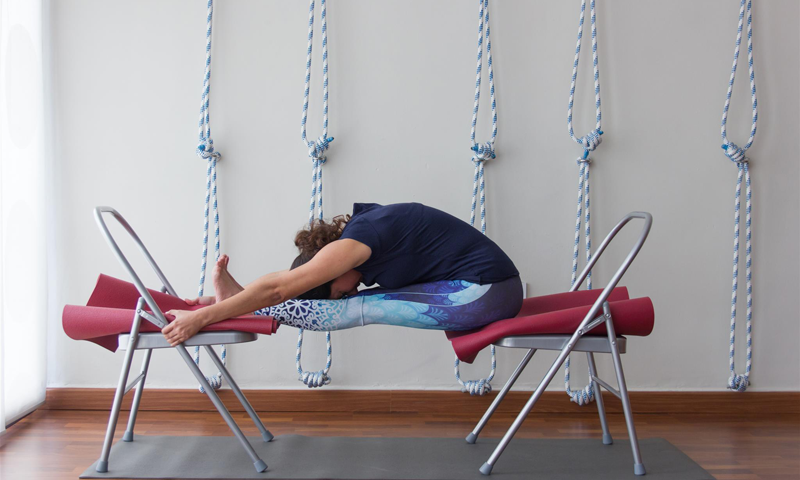
Everything You Need to Know about Yoga Straps
25th July 2018
What is a Yoga Blanket? Everything You Need to Know
2nd August 2018How to Use a Yoga Wheel

Many yogis enjoy using props to take their practice to the next level. One of the most popular props is the yoga wheel, a sturdy plastic wheel that can be used to aid flexibility and provide support. Additionally, the wheel can be used to help with balance and to even strengthen the core! To incorporate a yoga wheel into your practice, all you need is good-quality wheel and some comfortable yoga clothes. In this article, we explore exactly how to use a yoga wheel.
Open your shoulders
One of the main things you can use a wheel for is to open your shoulders. You can either roll on it whilst using pranayama or just lie on it to relax; just being on the wheel will help stress and tension to disappear from your shoulders. Many yogis refer to the wheel as an advanced yoga block. Lying on the wheel for a few minutes will release almost 10 times as much tension as lying on a block.
Open your sides
The wheel can also be used to open your sides. While the sides can be opened through traditional asanas, this can be quite tricky and take time, patience, and dedication to find the right position. However, using a yoga wheel has instant results. Lying sideways on the wheel will release tension from muscles that you didn’t even know you had! Additionally, the process will allow your body to move further during side-stretching asanas. To open your sides, simply lie sideways on the wheel and breathe deeply.
Open your back
Opening your back is easy with a yoga wheel. There are many standard asanas for opening the back; how-ever, these can put unnecessary strain on the muscles if you don’t practice correctly. As the wheel provides a high level of support, there is no worry of injuring your muscles. This allows you to move further into the pose and reap the most benefit from it. To open your back, place the wheel under your back and lie down. You can either roll the wheel up and down your back or find a position that feels good and leave it there. To increase the stretch, remember to breathe deeply throughout.
Advance your backbends
As well as opening the back, the yoga wheel can improve your flexibility. Greater flexibility will allow you to practice more complex backbends without over-stretching the muscles. To increase your flexibility, lie back on your wheel and take some deep breaths. After a few minutes, roll the wheel to a different part of your back and hold it there.
Improve your balance
Using a yoga wheel regularly can improve your balance. Once you can balance on the wheel, you can try more complex postures without the worry of losing your balance! When you start your balance training, keep your hands on the ground. As you improve, you can try standing on your wheel, instead. This will not only improve your flexibility but also strengthen your core. To prevent injury, it’s always best to practice on a soft floor or large yoga mat.
Improve flexibility
As well as making your back more flexible, the yoga wheel can improve flexibility all over the body. Many yogis enjoy using the wheel to open their hamstrings and hips. Doing this will open the lower body and give you a wider range of movement in standard asanas. To open the lower body, place the wheel beneath your legs and roll it gently.

Poses to use with a wheel/
Monkey Pose
Monkey Pose
To practice Monkey Pose, kneel on your mat with your wheel behind you. Raise your right leg up and place the sole of your foot on the mat. Stretch your left leg out behind you and place the top of your left foot and your knee on the ground. Next, carefully move your yoga wheel under your left ankle. Finally, open your chest and raise both arms above your head. You are in Monkey Pose. Once you have found your balance, bend your right knee to increase the stretch. Hold the asana for around 30 seconds whilst breathing deeply.
Pigeon Pose
To practice Pigeon Pose, kneel on your mat with your knees touching. Your bottom should rest securely on the mat in-between your feet. Next, raise your bottom a few inches off the ground and place your wheel under your lower back. Lean back over the wheel and feel your upper body open. For a deeper stretch, reach your arms back with your elbows bent and take hold of the wheel. You are in Pigeon Pose. Hold the asana for around 20 seconds, remembering to breathe deeply.
Double Forearm Pose
Double Forearm Pose should be practised with a partner. To practice the asana, you should both begin on your forearms and knees and hold the wheel in-between you. Next, shift your balance to your forearms and gradually lift your feet off the ground and back over your head. To keep your balance, gaze at your hands whilst you lift your legs up. Once you have found your balance, move your legs back until your feet touch your partners. You are in Double Forearm Pose. To avoid injury, it’s important to let your partner know when you are ready to exit the posture.
In Summary
Whether you’re an experienced yogi or a complete beginner, the yoga wheel can take your practice to the next level. In addition to opening the body, the wheel can provide support to make asanas easier. With this in mind, beginners may find a yoga wheel particularly helpful. For best results, try to wear tight-fitting clothes whilst using the wheel. A pair of leggings and a yoga bra will ensure your clothing doesn’t become wrapped around the wheel.

